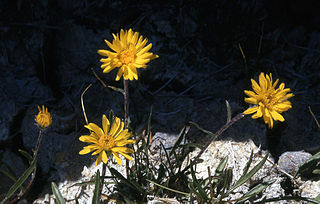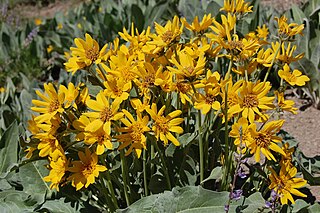Eriophyllum multicaule is a North American flowering plant in the family Asteraceae, known by the common name manystem woolly sunflower. It is native to California and Arizona in the southwestern United States.

Gnaphalium palustre, known by the common name western marsh cudweed, is a species of flowering plant in the family Asteraceae.
Hulsea californica is a rare species of flowering plant in the family Asteraceae known by the common names San Diego alpinegold and San Diego sunflower. It is endemic to southern California, where it grows only in the Peninsular Ranges.

Antennaria corymbosa is a North American species of flowering plants in the family Asteraceae known by the common names flat-top pussytoes or meadow pussytoes. It is native to western Canada and the Western United States south as far as Tulare County in California and Rio Arriba County in New Mexico. It grows in moist, cool areas such as mountain meadows and riverbanks. Most of the populations are found in the Rocky Mountains, the Cascades, and the Sierra Nevada.
Antennaria geyeri is a North American species of flowering plant in the family Asteraceae known by the common name pinewoods pussytoes or mountain pussytoes. It is native to the western United States where it grows in woodland and scrub very often on the forest floor under pine trees. It is found in Washington, Oregon, northern California, and northwestern Nevada.
Antennaria suffrutescens is a species of flowering plant in the family Asteraceae known by the common names evergreen pussytoes and evergreen everlasting. It is native to southwestern Oregon and far northeastern California. It grows in coniferous forests in the mountains, sometimes on serpentine soils.

Enceliopsis nudicaulis is a North American species of flowering plants in the family Asteraceae known by the common name nakedstem sunray, or naked-stemmed daisy.

Chaenactis suffrutescens is a species of flowering plant in the aster family known by the common name Shasta chaenactis.
Eriophyllum jepsonii is a rare North American species of flowering plant in the family Asteraceae known by the common name Jepson's woolly sunflower. It is endemic to California, where it has been found in the Central Coast Ranges and adjacent hills from Contra Costa County to Ventura County.
Lessingia arachnoidea is a rare species of flowering plant in the family Asteraceae known by the common name Crystal Springs lessingia. It is endemic to California, where it is known from a few occurrences in the vicinity of Crystal Springs Reservoir on the San Francisco Peninsula and southward to serpentine soil in Woodside. It may also exist in Sonoma County to the north. The plant grows in chaparral, scrub, grasslands and other local plant communities, on serpentine soils.

Psilocarphus brevissimus is a species of flowering plant in the family Asteraceae known by the common names short woollyheads, woolly marbles, and woolly heads.
Psilocarphus oregonus is a species of flowering plant in the family Asteraceae known by the common names Oregon woollyheads and Oregon woolly marbles. It is native to western North America from Washington and Idaho to Baja California, where it grows in seasonally wet habitat, such as vernal pools.

Psilocarphus tenellus is a species of flowering plant in the family Asteraceae known by the common names slender woollyheads and slender woolly marbles. It is native to western North America from far southwestern British Columbia to Baja California, where it grows in seasonally wet habitat, such as vernal pools, as well as coastline and disturbed areas.

Pyrrocoma uniflora is a species of flowering plant in the family Asteraceae known by the common name plantain goldenweed. It is native to western North America from central Canada to California to Colorado, where it grows in several types of habitat, including forest and meadows with alkali soils, such as those near hot springs. It is a perennial herb growing up to 40 centimeters tall, the stems reddish and usually with a thin to thick coating of woolly fibers. The lance-shaped, toothed leaves are usually woolly, the largest near the base of the plant reaching up to 12 centimeters in length. The inflorescence is a single flower head or a cluster of a few heads, each lined with woolly phyllaries. The head contains yellow disc and ray florets. The fruit is an achene which may be over a centimeter long including its long pappus.
Senecio clarkianus is a species of flowering plant in the aster family known by the common name Clark's ragwort. It is endemic to the Sierra Nevada of California, where it grows in the moist meadows on the western slopes of the range. It is a perennial herb growing up to 1.2 meters tall from a caudex and fibrous root system. The solitary erect stem is lined evenly with leaves up to about 18 centimeters long, their blades deeply lobed or dissected into narrow, pointed segments. The herbage is hairy to woolly in texture. The inflorescence bears several flower heads which are lined with green-tipped phyllaries. They contain many yellow disc florets and each has usually 8 or 13 narrow yellow ray florets about a centimeter long, sometimes longer.

Sphenosciadium is a monotypic genus of flowering plants in the family Apiaceae containing the single species Sphenosciadium capitellatum, which is known by the common names woollyhead parsnip, ranger's buttons, button parsley, and swamp white heads.
Stylocline intertexta is a species of flowering plant in the family Asteraceae known by the common names Morefield's neststraw and Mojave neststraw. It is native to the Mojave and Sonoran Deserts of California, Nevada, Utah, and Arizona, where it grows in rocky, sandy desert soils. It likely evolved as a hybrid between woollyhead neststraw and baretwig neststraw ; it is a mix of their morphological traits and it occurs alongside both of them. It reproduces itself, producing fertile offspring, and it meets other criteria for any other definition of a species, so it was described to science as such in 1992. It is a small annual herb growing at ground level and reaching just a few centimeters in length. It is usually coated in white hairs, often woolly. The small, pointed leaves are oval to lance-shaped and measure up to 1.5 centimeters long. The inflorescence bears spherical flower heads each a few millimeters in diameter. The head has no phyllaries, just a ball of tiny woolly white flowers.

Wyethia mollis is a species of flowering plant in the family Asteraceae known by the common name woolly mule's ears. The plant is hairy to woolly in texture, sometimes losing its hairs with age.

Packera franciscana is a rare species of flowering plant in the aster family known by the common name San Francisco Peaks groundsel, or San Francisco Peaks ragwort. It is endemic to Arizona in the United States, where it is known only from the San Francisco Peaks in Coconino County. It is threatened by recreational activities in its habitat. It is a federally listed threatened species of the United States.
Eriogonum coloradense is a species of flowering plant in the buckwheat family known by the common name Colorado buckwheat. It is endemic to Colorado in the United States.










